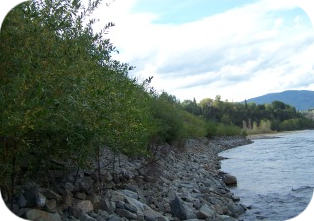Application: Canals, culverts and drains, dykes, embankments, floodgates, stormwater outfall
Description: Vegetated riprap incorporates a combination of rock and native vegetation in the form of live cuttings. Long and living willow or cottonwood posts, for example, can be planted in conjunction with the placement of rock used to armour the banks of watercourses or redirect flows. Adding vegetation to riprap can protect the soil surface from erosive forces or improve stability of soil slopes that are subject to seepage or have poor soil structure through the development of root mass. In addition, it provides a more natural appearance to the installed rocks. Woody vegetation establishment will prevent soil loss (piping) from behind the structures and increase pull-out resistance. Five methods for construction that have proven effective are: vegetated riprap with willow bundles; vegetated riprap with bent poles; vegetated riprap with brush layering and pole planting; and vegetated riprap with soil cover, grass and ground cover and joint or live stake planted riprap.
Contribution to climate resilience: Vegetated riprap prevents bank erosion by protecting the surface and undermining of slopes. It also increases the resilience of local communities to drought by creating a habitat for fish (an alternative source of food to agriculture), and supplying fodder for local livestock. Because they are developed using local labour and locally available materials, they require less energy to produce, are far more sustainable, and can be applied in as quick a timeframe as traditional civil engineering work.
Supplementary sources of information:
http://www.terraerosion.com/VegetatedRiprap.htm
http://docs.trinitycounty.org/departments/Planning/PDF/Environ-IS/Monitoring%20Plan%20AppendixA.pdf
http://dnr.wi.gov/topic/Waterways/shoreline/erosioncontrol-vegetated.html
http://www.intechopen.com/source/html/17257/media/image3.png
Background image credit: https://www.geograph.org.uk/photo/3005144
This resilience-building measure is sourced from the Water Resource Adaptation Guide (2019) published by the National Council for Sustainable Development at the Ministry of Environment in Cambodia. The full Guide is available to download at URL https://ncsd.moe.gov.kh/sites/default/files/2019-10/Water%20Resources%20Adaptation%20Guide_March%202019_En.pdf


